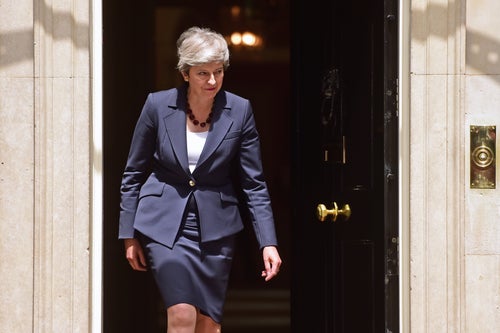

Whether pushed out by voters, the party or your Cabinet colleagues, most prime ministerial departures are tearful affairs.
Like Theresa May, most premiers leave with regret about unfinished business. There is also an intensity about working in Number Ten which means the ending, when it comes, is usually a highly charged and emotional experience for everyone there.
Although I spent just three years in Downing Street, working for Gordon Brown and David Cameron, it felt, rather like dog years, considerably longer.
At its worst, the experience was a cross between the fall of Saigon – with Sky News supplying the helicopters – and the Führerbunker. At its best, the feel was a blend of the West Wing and a grand library.
Under Brown, any day without a crisis seemed like a holiday. Some were real world crises, such as the breakdown of the banking system, while others, looking back, were just small fires that we should have left to burn out by themselves. As the civil servant responsible for ‘strategic communications’, my job was the long-term planning of government announcements. Nothing was more dispiriting than seeing a campaign that had been weeks in preparation getting completely blown off the news agenda by a picture of David Miliband holding a banana.
Part of our job was getting government departments to tell you what they were up to so their news could be given a slot on the famous Downing Street ‘grid’. One clear sign that an administration is nearing the end of its days is when departments ‘go rogue’ and do their own thing – we saw examples of that behaviour towards the end of New Labour and we saw it in spades under Mrs May.
The layout of Number Ten itself fosters a bunker mentality. Beyond the state rooms, most people in Downing Street are working in cramped, overheated conditions, with shabby carpets and crap IT. Go out for a walk, perhaps in St James’s Park, and the snappers are there to try and take a picture of you and any documents you may be carrying.
You can tell that the end is coming when more and more journalists set up camp in Downing Street. It’s a very surreal feeling to see the front door of your place of work being streamed live on TV. The news helicopters whirring overhead add to the sense of siege.
Yet, all the time, the corridor linking the famous black door with the Cabinet Room, remains becalmed. Duty clerks and private secretaries glide effortlessly from room to room carrying papers or cups of tea.
In my time, this air of calm would occasionally be punctuated by one of Gordon’s volcanic eruptions. But at least, for the staff, we knew where we stood. The picture that emerges of Mrs May is of a PM who didn’t know her own mind and whose unofficial epitaph is likely to be that blank Private Eye front page,reading: “Theresa May’s legacy in full”.
Mrs May valiantly, I suppose, continued to argue for her Brexit deal until logic and the numbers made it impossible. To paraphrase Margaret Thatcher, in No10 you fight on and fight to win. That is, until you can’t any more – and then the denouement is sudden, brutal and palpable.
Gordon Brown had at least some time to contemplate departure. Not only were the polls bad for some time, the indecisive nature of the general election of May 2010 led to five days of coalition negotiations before the game was finally up.
When the moment arrived for him to leave Downing Street for the final time, just before nightfall, it was emotional for all of us, civil servant and political aide alike. There is something unique about the experience of working for a prime minister which fosters a special bond. When Gordon, Sarah and the boys left, there were tears and hugs all round. I am sure there’ll be a similar scene when Theresa and Philip May finally head for the palace.
However, our system of government will carry on and, just as it does with Doctor Who, a natural process of regeneration will take place. Seconds after Gordon got in his Jag to go and see the Queen, the most senior civil servant in Downing Street, dear Jeremy Heywood, said to all of us remaining: “right, 45 minutes to get ready for the next lot”.
The king (or queen) is dead, long live the... and so on.
Mark Flanagan was head of strategic communications at the Prime Minister’s Office from 2007-2010 and is now UK Managing Director at Portland Communications